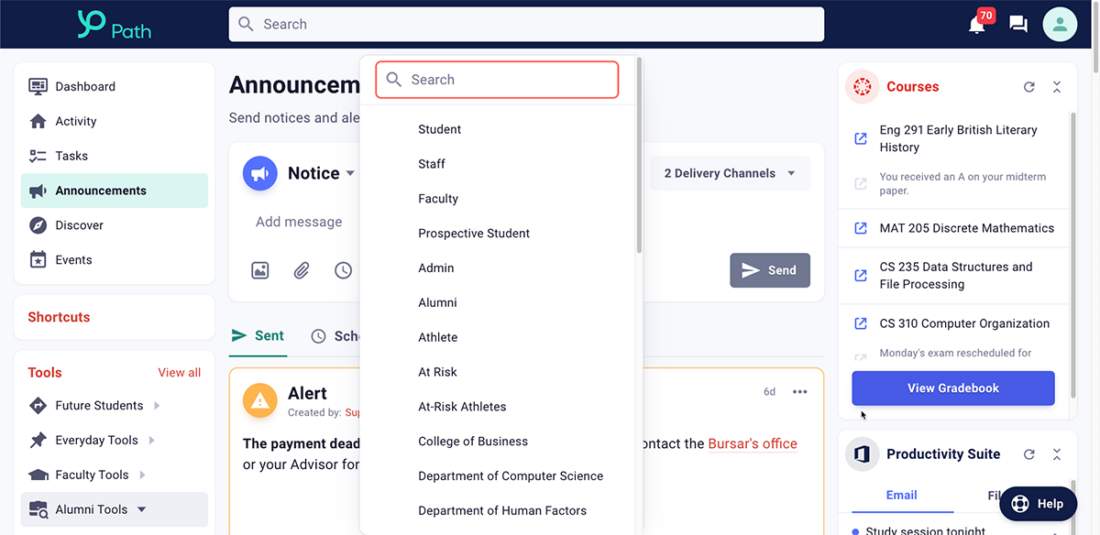How would you describe yourself? That’s not a simple question because people are not simple. Every one of us encompasses many roles based on who we are, what we do, where we live and work, our interests and a million other factors.
In a higher ed setting, a student isn’t just a student. A student may be a:
- Junior
- Physical therapy major
- Journalism minor
- Field hockey player
- Sports scholarship recipient
- Resident assistant at the university’s main campus
But they might also:
- Have studied abroad last year
- Serve as an editor for the student newspaper
- Take art classes for fun
- Rely on campus and public transportation
- Go to every football game
We’re complex beings, but until recently the world — including higher education institutions — has communicated in overly generalized ways. In our media-saturated, always-on world, people are drowning in communication and advertising that just doesn’t pertain to them. Personalized experiences are rising to solve that challenge.
Personalization is the New Norm
Personalization aims to cut through the noise by offering things that we know (or strongly suspect) people will be interested in. And people like it. According to Twilio Segment’s The State of Personalization 2021 report:
- 52% of consumers agree that as digital experiences become more personalized, their satisfaction improves
- 48% of consumers appreciate the convenience of personalization, so long as their data is secure
In fact, personalization is becoming table stakes in the eyes of consumers. Twilio Segment found that 45% of consumers say they’re likely to take their business elsewhere if a brand doesn’t offer a personalized experience.
Students Crave Personalization
Today’s students largely grew up in a data-driven, digital world. They’re used to consumer products — everything from retail ads to Netflix movie recommendations — targeting them with highly personalized communications based on their persona and past habits. Anything that isn’t tailored to them specifically is just noise … and they’ll largely ignore it. The 2020 Generation Influence: Reaching Gen Z in the New Digital Paradigm found that 41% of Gen Z will leave a website if it doesn’t predict what they like, want or need.
Because this is the world they have always lived in and prefer, students expect the same experience when it comes to their education. Salesforce’s 2021 Connected Student Report found that about half of students want to receive more personalized communications from their institutions. One in four students want a more personalized education experience that better meets their needs, the report found.
Why Personalization in Higher Ed Matters
Treating students as a general student body isn’t good enough anymore. Schools need to treat each student as an individual, with their own unique set of roles and interests. Assigning students granular roles (e.g. Class of 2024, Main Campus Resident, Biology Major, Student Athlete) allows institutions to tailor communication to only the information that matters and is of interest to that particular student. With the sheer amount of information, activities, events, services and resources associated with higher ed, personalizing communication is key to not overwhelming students with a barrage of information. The goal is to surface what’s important to that individual and background the rest.
This personalized approach to each individual creates a clearer path to their interest and opportunities and can help them find the information, services and resources they need to succeed (even if they had no idea those resources existed). Ultimately, it’s about helping each student focus and succeed by creating a personalized path specifically for them.
Get Granular with Roles
The key to success is to get granular when assigning students to roles. Yes, there are times you’ll need to message the entire student body, but there are also times you’ll want to target a specific subset of students. Setting up fairly granular roles allows you to reach the specific group you need to without sending announcements, alerts or other communications to students who are outside the message’s target audience. By only sending students pertinent information, you’ll increase engagement and students will learn to pay attention to communications because it’s always important to them specifically.
When creating roles, start with large umbrella groups (All Students, Freshman, Juniors) then drill down by things like major, school, campus, clubs, activities and any other categorization you can image targeting. Keep it broad enough that it captures a good chunk of students (you don’t necessarily need a role that only 5 students fit), but specific enough that you can see the need to message only that group. As time goes on, reevaluate the roles you have in place to identify ones that aren’t being used or roles that are missing but would be helpful to have.

Students want a personalized education experience and incoming classes are going to expect personalization even more. The ability to be nuanced in what you show students, how you communicate and how you help them succeed is a foundational step toward a more personalized higher education experience.
